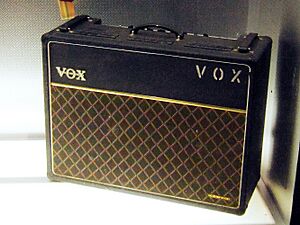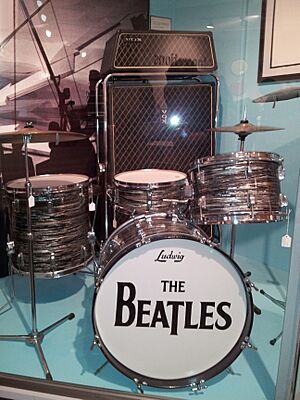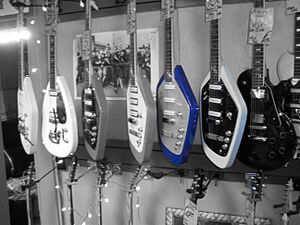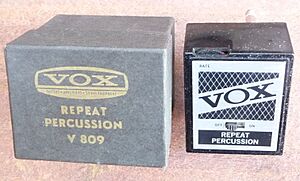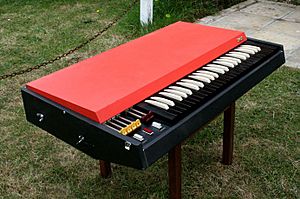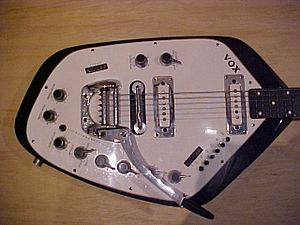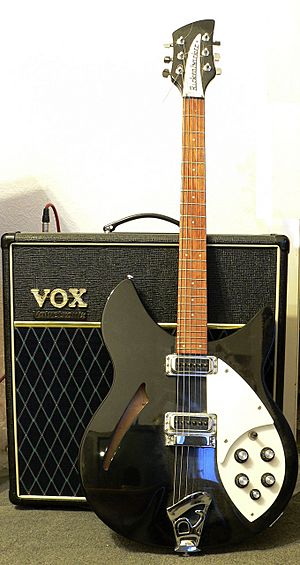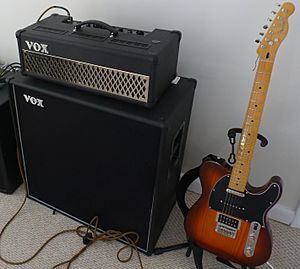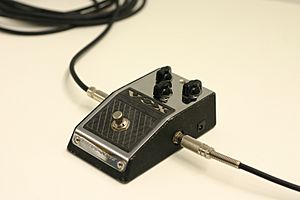Vox (company) facts for kids
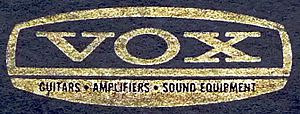
Vox logo showing product categories
|
|
| Privately held company | |
| Industry | Musical instruments |
| Founded | 1957 |
| Founder | Thomas Walter Jennings |
| Headquarters | , |
|
Area served
|
Global |
| Products | Electric guitars Bass guitars Amplifiers Electronic organs Electric ukuleles Electric mandolins |
| Parent | Korg |
Vox is a famous British company that makes musical equipment. It was started in 1957 by Thomas Walter Jennings in Dartford, England. Vox is best known for its amazing guitar amplifiers, especially the Vox AC30. Many legendary bands like The Beatles, The Rolling Stones, Queen, and U2 have used the AC30.
Vox also made the Vox Continental electric organ, the famous Vox wah-wah pedal used by Jimi Hendrix, and many cool electric guitars and bass guitars. Since 1992, a Japanese company called Korg has owned Vox.
Contents
History of Vox
How it Started
The company that became Vox was first called the Jennings Organ Company. It was founded by Thomas Walter Jennings in Dartford, England, after World War II. His first successful product was the Univox, an early electronic keyboard.
In 1956, Jennings met Dick Denney, a guitarist who had designed a new guitar amplifier. The company then changed its name to Jennings Musical Industries, or JMI. In 1958, they launched the 15-watt Vox AC15 amplifier. The word "vox" means "voice" in Latin. This amplifier became very popular with bands like The Shadows and other British rock 'n' roll musicians.
Vox also made a smaller, simpler amplifier called the AC10 in 1959. It was designed for students and was stopped in 1965.
The Famous AC30 Amplifier
In 1959, bands wanted louder amplifiers. So, Vox created a more powerful version of the AC15 and called it the AC30. This amplifier had special speakers and a "Top Boost" feature. It used vacuum tubes, which are also called valves.
The AC30 helped create the sound of the "British Invasion" music. It was used by The Beatles, The Rolling Stones, The Kinks, and the Yardbirds. Later, famous guitarists like Brian May from Queen, Paul Weller from The Jam, and The Edge from U2 also used the AC30. Many other artists, including Mark Knopfler and Tom Petty, have also played through the Vox AC30.
Other Amplifiers
When The Beatles started using Vox amplifiers, they needed even louder ones for their big shows. John Lennon and George Harrison first used AC15 and AC30 amps. Later, they got bigger and louder Vox amplifiers like the AC50 and AC100. These amps were huge, with multiple speakers.
Paul McCartney used one of the first transistor amplifiers, the T60. It had a separate speaker cabinet. The Beatles used many special Vox amplifiers during their career, especially for albums like Revolver and Sgt. Pepper's Lonely Hearts Club Band.
In the United States, the Thomas Organ Company distributed Vox amps. They made a solid-state (non-tube) version of the AC100, called the "Super Beatle" amplifier. This was to connect with The Beatles' popularity. However, it wasn't as popular as the tube AC30.
Tom Petty and the Heartbreakers also used the Super Beatle amps on stage. But their guitarist, Mike Campbell, later said that the Super Beatle amps were mostly for show. Their actual guitar sound came from other amplifiers hidden behind them.
Vox Instruments
Guitars
 |
 |
| Vox Phantom VI | Vox Mark VI |
Vox's first electric guitars were the Apache, Stroller, and Clubman. They looked like Fender guitars, which were hard to find in the UK back then. These early guitars were affordable.
In 1962, Vox introduced a unique, five-sided guitar called the Phantom. It was first made in England, then in Italy. The Phantom guitars were used by bands like The Echoes. They had a unique shape and a vibrato bridge.
A year later, Vox made the teardrop-shaped Mark VI guitar. The first one was made for Brian Jones of The Rolling Stones. Later, the Stones' bassist Bill Wyman was shown with a teardrop-shaped bass made by Vox.
Vox also experimented with guitars that had built-in effects. These included the Cheetah, Ultrasonic, and Invader. Some had push buttons to turn on effects like distortion.
When 12-string guitars became popular in the mid-1960s, Vox released the Phantom XII and Mark XII. These guitars had a special 12-string vibrato system.
Vox also sold guitar pedals and effects. These included an early version of the wah-wah pedal used by Jimi Hendrix. Another famous pedal was the Tone Bender fuzzbox, used by Jimmy Page of Led Zeppelin and The Beatles.
In 1967, Vox introduced guitars with built-in effects like distortion, tremolo, and a wah-wah pedal that you could control with your picking hand.
Vox was also a pioneer in creating the first wireless microphone system. This allowed singers to move freely on stage without cables.
 |
 |
| Vox Standard 24 | Vox Virage DC |
In 1982, all Vox guitar production moved to Japan. The guitars made there, like the Standard & Custom 24, were considered very high quality. Later, production moved to Korea.
In 1998, Vox re-released many of their classic Phantom and Teardrop guitars. More recently, in 2008, Vox introduced the Virage series of semi-hollow guitars. These guitars had a special ergonomic design and new pickups.
In 2013, a Vox guitar used by George Harrison and John Lennon from The Beatles sold for a lot of money at an auction. Later, the artist Prince often used the Vox HDC-77 guitar.
Organs
The Vox brand also made electronic organs. The most famous was the Vox Continental, released in 1962. It used transistors to make sound.
The Beatles' John Lennon played a Vox Continental live, including at their 1965 concert at Shea Stadium. Many other British bands like the Dave Clark Five and the Animals used it. In America, Paul Revere and The Doors' Ray Manzarek also played the Continental. You can hear it on songs like the Monkees' "I'm a Believer" and Van Morrison's "Brown Eyed Girl".
| width1=180|caption1= Vox Jaguar | width2=180|caption2=Vox Super Continental | width3=0 |
The Continental and other Vox organs, like the Jaguar, had a distinct look. They often had orange and black coverings, chrome stands, and reversed black and white keys.
GuitarOrgan
In 1966, Vox introduced the Guitar Organ. This was a Phantom VI guitar with special electronics inside that could make organ sounds. You could play organ tones by pressing strings onto the frets. It was a very heavy instrument with a steel neck.
This instrument was quite new for its time, but it never became very popular. It was a very early example of what we now call a guitar synthesizer.
Growth, New Technology, and Challenges
Vox grew very quickly in the early 1960s as more musicians used their equipment. However, their tube amplifiers sometimes had problems with overheating. This led Vox and other companies to start making solid-state (transistor-based) amplifiers.
In 1964, Tom Jennings partnered with the Thomas Organ Company in the United States. They started importing Vox products to the US. Jennings later sold most of his company, JMI, to a British company called the Royston Group. He stayed as CEO until 1969.
The Thomas Organ Company also started making their own Vox-branded amplifiers in the US. These were mostly solid-state. They even created a special car called the Voxmobile, which looked like a Phantom guitar, to promote the brand. Despite these efforts, Vox's popularity declined for a while.
Tom Jennings later started a new company, Jennings Electronic Industries, which continued to make updated versions of the AC30.
During the 1970s, the Vox brand changed owners several times. The AC30 continued to be made, but with some changes to save costs. For example, they used different speakers and materials.
In 1978, Rose Morris bought Vox. They tried to make the brand strong again, continuing to build the AC30 and introducing new amplifiers.
Finally, in 1992, Korg bought most of Rose Morris, including the Vox product lines. Korg then focused on bringing back the classic Vox sound.
Modern Vox Products
Korg helped Vox bring back the original sound of the AC30 amplifier. They started using the old-style tube rectifiers and special speakers again. In 2005, production moved to Vietnam, and they redesigned the AC30, now called the AC30C2. They also made a special "hand-wired" version for a more classic sound.
The AC10 amplifier was also brought back in 2015.
Night Train Amplifiers
In 2009, Vox introduced the Night Train series of compact, all-tube amplifier heads. These amps were small and looked a bit like a lunchbox. The first one was the 15-watt Night Train (NT15H). It used special tubes to create its sound.
Later, Vox released smaller (2-watt) and larger (50-watt) versions of the Night Train. All Night Train models had a switch to choose between a classic Vox sound and a more modern, high-gain sound. These amps were designed to be used with separate speaker cabinets.
In 2013, updated "G2" versions of the Night Train amps were released. They added features like a second channel and digital reverb. The Night Train series was stopped in 2017.
Digital Modelling Amplifiers
In 2001, Korg introduced the Vox Valvetronix line. These were digital modelling amplifiers. This means they used computer software to copy the sounds of many different classic amplifiers. They had a special tube preamp section to give them a warm, tube-like feel.
The Valvetronix amps could imitate the sounds of 11 different amplifiers and had many built-in effects. Later versions, like the Valvetronix VT series, could model even more amplifiers (up to 22).
Vox also made smaller, portable modelling amps like the Vox Mini3.
In 2015, Vox released the MV50 series of small, hybrid amplifier heads. These amps used a new type of vacuum tube called the Nutube 6P1. Each MV50 amp was designed to sound like a specific style of classic amplifier.
More recently, Vox has continued to use Nutube technology in amps like the VX50GTV and the Cambridge50. These amps can model 11 different amplifier sounds, including classic Vox amps, Marshall amps, and Fender amps.
Cooltron Pedals
Vox also created a line of analog effects pedals called Cooltron. These pedals were designed to give guitarists vintage sounds like overdrive, compression, and tremolo. They used small tubes to create a warm, classic sound.
Two of the Cooltron pedals, the Big Ben Overdrive and the Bulldog Distortion, won awards from Guitar World magazine.
|
See also
 In Spanish: Vox Amplification para niños
In Spanish: Vox Amplification para niños
- Vintage musical equipment
- Jennings Musical Instruments
- Vox Bass Guitar
- Octave twelve (Vox Mando-Guitar)



